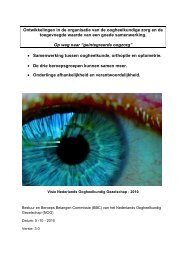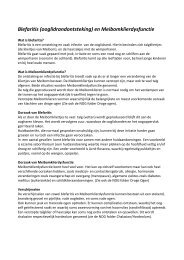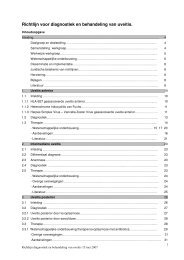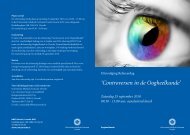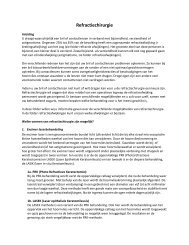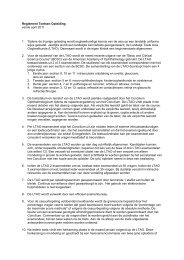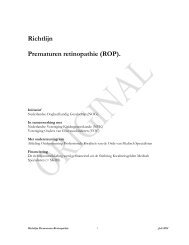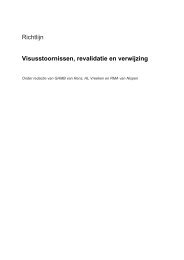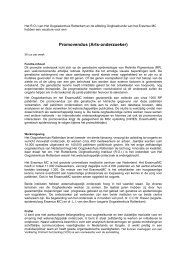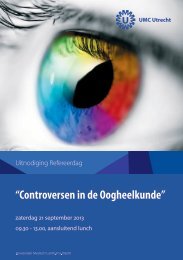terminology and guidelines for glaucoma ii - Kwaliteitskoepel
terminology and guidelines for glaucoma ii - Kwaliteitskoepel
terminology and guidelines for glaucoma ii - Kwaliteitskoepel
Create successful ePaper yourself
Turn your PDF publications into a flip-book with our unique Google optimized e-Paper software.
2.1 - PRIMARY CONGENITAL FORMS<br />
2.1.1 - PRIMARY CONGENITAL GLAUCOMA<br />
Etiology: Angle dysgenesis<br />
Pathomechanism: Decreased aqueous outflow<br />
Features:<br />
Onset: from birth to second year of life<br />
Heredity: usually sporadic, up to 10% recessive inheritance with variable penetrance<br />
Gender: more common in males (65%)<br />
Specific chromosomal abnormalities have been identified at 1p36 <strong>and</strong> 2q21<br />
Signs <strong>and</strong> symptoms:<br />
Photophobia, tearing, blepharospasm, eye rubbing<br />
IOP in general anesthesia: insufficient alone to confirm the diagnosis unless extremely elevated since general<br />
anesthesia may lower the IOP<br />
Corneal diameter > 11 mm (buphthalmos)<br />
Corneal edema (+/- ruptures of Descemet’s Membrane.)<br />
Optic nerve head: pressure distension/uni<strong>for</strong>m cup enlargement (CDR >0.3)<br />
Gonioscopy: open-angle<br />
poorly differentiated structures<br />
trabeculodysgenesis (including ‘Barkan´s membrane’)<br />
anterior insertion of the iris<br />
2.1.2 - PRIMARY INFANTILE GLAUCOMA / Late-Onset Primary Congenital Glaucoma<br />
Etiology: Angle dysgenesis<br />
Pathomechanism: Decreased aqueous outflow<br />
Features:<br />
Onset: third to tenth year of life<br />
Heredity: usually sporadic, up to 10% recessive inheritance with variable penetrance<br />
Signs <strong>and</strong> symptoms:<br />
Pain unusual, often presents late with symptomatic visual field loss<br />
Peak IOP: > 24 mm Hg without treatment<br />
Cornea: Diameter: < 11 mm (no buphthalmos, no corneal edema)<br />
Optic nerve head: pressure distension/cup enlargement with diffuse rim damage<br />
Gonioscopy: open-angle<br />
poorly differentiated structures, trabeculodysgenesis<br />
anterior insertion of the iris<br />
2.1.3 - GLAUCOMA ASSOCIATED WITH CONGENITAL ANOMALIES<br />
a. Anidria<br />
b. Sturge-Weber syndrome<br />
c. Neurofibromatosis<br />
d. Marfan syndrome<br />
e. Pierre Robin syndrome<br />
f. Homocystinuria<br />
g. Goniodysgenesis: g.1 - Axenfeld-Rieger syndrome<br />
g.2 - Peter’s anomaly<br />
h. Lowe’s syndrome<br />
i. Microspherophakia<br />
j. Microcornea<br />
k. Rubella<br />
l. Chromosomal abnormalities<br />
m. Broad thumb syndrome<br />
n. Persistent hyperplastic primary vitreous<br />
Ch. 2 - 4 EGS



